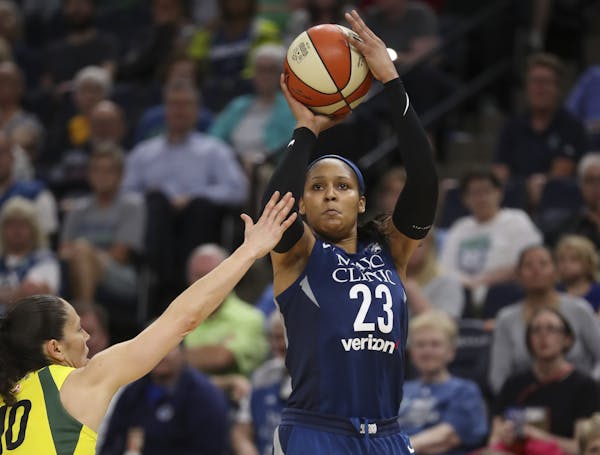The Lynx haven't looked great this year, and didn't look like a great rebounding team in their latest loss to Connecticut. With Rebekkah Brunson out, the Sun dominated the Lynx on the glass 41-27 in a 83-64 victory.
But that performance is what those who study statistics would refer to as an outlier. The Lynx can't blame their struggles this year on their rebounding.
"We're going to block the last game out," center Sylvia Fowles said.
Even if you don't block it out, the Lynx are still on pace to set a WNBA record in one important category related to rebounding — defensive rebounding percentage.
That statistic tries to provide more information than just the total number of rebounds a team pulls down. It tracks how many defensive rebounds were available and shows how many the team grabbed. The Lynx lead the WNBA at 80.3 percent, which would top the single-season record in that category of 78.8, set last season by the New York Liberty.
"Now I have to be extra cautious about that," Fowles said.
Fowles is the main reason for this record pace. She leads the Lynx and the league with 11.9 rebounds per game, with Brunson second on the team at 7.3. Fowles is especially dominant on the defensive glass with a 28.9 defensive rebound percentage. That's a higher rate than any player who has played in at least 15 games and averages more than 12 minutes.
"You have to have the willpower. Rebounding is the dirty work," Fowles said. "You don't want to get up, get hit between three people to get a rebound. But it's all about will and guts. I'm happy I have a lot of people on my team who take pride in rebounding. They make my job a whole lot easier."
For the Lynx, rebounds, specifically on the defensive end, have been one constant in an otherwise inconsistent season — and with Brunson listed as probable for Wednesday's game against the Fever, perhaps Fowles won't have as much pressure on her as she did Sunday.
"It's a key to us being able to finish games and to give ourselves a chance to win," forward Maya Moore said. "So having that mind-set and a lot of that has to do with the way we defend in the half-court. Finishing plays with rebounds is a really big part of finishing the defensive possessions."
On the other end, the Lynx are fifth in the league in grabbing 26 percent of available offensive rebounds, down about four percentage points from a season ago. But the defensive rebounding is one of the things keeping the Lynx afloat as they try to recapture their championship form.
Fowles said as she gets older, she has had to be savvier with how she rebounds and tries to mix boxing out her opponents with reading how a shot might fall off the rim.
"My thing is how can I get a piece of body on you but also see how it's coming off the rim?" Fowles said. "It's 50-50 for me. I'm at the age where I still can jump, but you got a lot of players who can jump. How can I stop them a little bit but at the same time give myself a chance?"
However she and her teammates go about it, it's working.
Chris Hine is the lead writer for North Score, the Star Tribune's sports analytics beat. startribune.com/northscore E-mail: chris.hine@startribune.com

Reusse: Once-formidable Twins starting rotation vulnerable without López

Twins lose second in a row to Blue Jays as bullpen falters late
What is the 'House settlement,' and what does it mean for the Gophers and NCAA?

